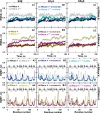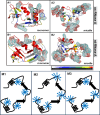Interaction of Anionic Surfactants with Native and Partially Unfolded RNase A: Binding Kinetics, Structural Changes, and Stability
- PMID: 40621027
- PMCID: PMC12223854
- DOI: 10.1021/acsomega.5c01998
Interaction of Anionic Surfactants with Native and Partially Unfolded RNase A: Binding Kinetics, Structural Changes, and Stability
Abstract
In protein-surfactant interactions, the alkyl chain length of surfactants and the surface-exposed residues of proteins play essential roles in binding and unfolding. To investigate this, the interactions of sodium octyl (SOS), decyl (SDeS), and dodecyl (SDoS) sulfates were studied with native and partially unfolded forms of ribonuclease A (ox-RNase A and rd-RNase A) by using surface plasmon resonance (SPR), optical spectroscopy, and molecular dynamics (MD) simulations. rd-RNase A was obtained by partial reduction of the disulfide bonds of RNase A. MD simulations of RNase A in its native and unfolded states were carried out in the presence of all three surfactants in their monomeric and micellar concentrations, respectively. The binding affinity of surfactants differs between ox-RNase A and rd-RNase A. Monomeric forms of the surfactants do not affect the structure and stability of either form of RNase A. Upon micelle formation of the surfactants, ox-RNase A loses its tertiary interactions along with β-sheets. However, it forms non-native α-helices that gradually destabilize ox-RNase A. rd-RNase A initially forms more β-sheets, which stabilize the protein. Further increases in surfactant concentrations destabilize the β-sheets and induce the formation of non-native α-helices. MD simulation results suggest that rd-RNase A induces micelle formation with higher aggregation numbers than ox-RNase A. At monomeric concentrations, the interactions of surfactants could be predominantly ionic, whereas at micellar concentrations, hydrophobic interactions contribute significantly. The exposed hydrophobic surfaces of partially unfolded rd-RNase A facilitate binding of the surfactant to the protein. This results in differences in the unfolding pathways of rd-RNase A and ox-RNase A.
© 2025 The Authors. Published by American Chemical Society.
Figures









Similar articles
-
Prescription of Controlled Substances: Benefits and Risks.2025 Jul 6. In: StatPearls [Internet]. Treasure Island (FL): StatPearls Publishing; 2025 Jan–. 2025 Jul 6. In: StatPearls [Internet]. Treasure Island (FL): StatPearls Publishing; 2025 Jan–. PMID: 30726003 Free Books & Documents.
-
Impact of residual disease as a prognostic factor for survival in women with advanced epithelial ovarian cancer after primary surgery.Cochrane Database Syst Rev. 2022 Sep 26;9(9):CD015048. doi: 10.1002/14651858.CD015048.pub2. Cochrane Database Syst Rev. 2022. PMID: 36161421 Free PMC article.
-
Neuraminidase inhibitors for preventing and treating influenza in adults and children.Cochrane Database Syst Rev. 2014 Apr 10;2014(4):CD008965. doi: 10.1002/14651858.CD008965.pub4. Cochrane Database Syst Rev. 2014. PMID: 24718923 Free PMC article.
-
Sexual Harassment and Prevention Training.2024 Mar 29. In: StatPearls [Internet]. Treasure Island (FL): StatPearls Publishing; 2025 Jan–. 2024 Mar 29. In: StatPearls [Internet]. Treasure Island (FL): StatPearls Publishing; 2025 Jan–. PMID: 36508513 Free Books & Documents.
-
Systemic pharmacological treatments for chronic plaque psoriasis: a network meta-analysis.Cochrane Database Syst Rev. 2021 Apr 19;4(4):CD011535. doi: 10.1002/14651858.CD011535.pub4. Cochrane Database Syst Rev. 2021. Update in: Cochrane Database Syst Rev. 2022 May 23;5:CD011535. doi: 10.1002/14651858.CD011535.pub5. PMID: 33871055 Free PMC article. Updated.
References
-
- Kralova I., Sjöblom J.. Surfactants Used in Food Industry: A Review. J. Dispers Sci. Technol. 2009;30(9):1363–1383. doi: 10.1080/01932690902735561. - DOI
-
- Shaban S. M., Kang J., Kim D.-H.. Surfactants: Recent Advances and Their Applications. Composites Communications. 2020;22:100537. doi: 10.1016/j.coco.2020.100537. - DOI
-
- Moon S. Y., Kusunose T., Sekino T.. CTAB-Assisted Synthesis of Size- and Shape-Controlled Gold Nanoparticles in SDS Aqueous Solution. Mater. Lett. 2009;63:2038–2040. doi: 10.1016/j.matlet.2009.06.047. - DOI
LinkOut - more resources
Full Text Sources
Research Materials
Miscellaneous
